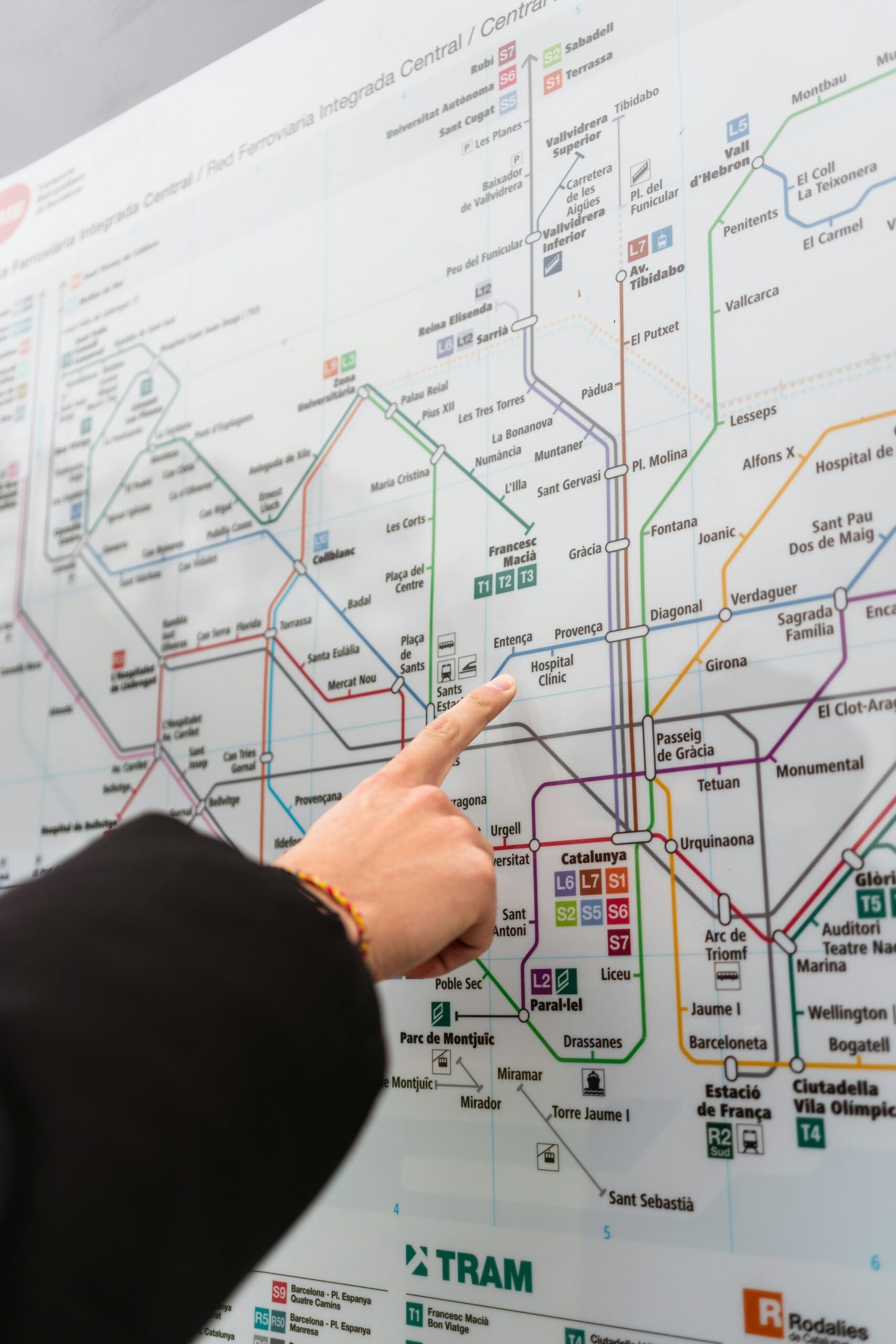Are you looking to explore the vibrant city of Perth but feeling overwhelmed by the complex Perth train map? You’re not alone! Navigating through Perth’s extensive rail network can be a challenge, especially for first-time visitors or daily commuters. Did you know that understanding the Perth train routes and services can save you both time and money? Imagine having a detailed, easy-to-read guide that highlights every station, line, and connection—sounds amazing, right? The Perth public transport map is more than just a tool; it’s your key to unlocking the city’s hidden gems and must-visit destinations. Whether you’re planning a quick trip to Fremantle or a longer journey to Mandurah, getting familiar with the Perth train timetable is essential. But what’s the best way to access an updated and interactive map that suits your travel needs? Stay tuned as we dive deep into the latest Perth train network updates and offer insider tips to master the rail system like a local. Don’t let confusing routes and schedules hold you back from experiencing Perth’s charm—discover the secrets behind the best Perth train apps and how they can revolutionise your daily commute. Ready to become a Perth train pro? Let’s get started!
Unlock Perth’s Best Kept Secrets: Hidden Routes on the Perth Train Map
Perth Train Map: Navigating the City’s Rail System Can Be Tricky, Eh?
If you ever found yourself wandering around Perth and needing to hop on a train, you might have realised that understanding the Perth train map is not as straightforward as it sounds. Not really sure why this matters, but the map seems to have been designed by someone who loves to keep passengers guessing. Anyway, let’s dive into the madness of Perth’s train system with all its quirks and oddities.
First off, the Perth train map covers a surprisingly wide area considering Perth ain’t exactly London or Sydney. You got five main lines – the Joondalup Line, Mandurah Line, Midland Line, Armadale Line, and Fremantle Line. These lines kinda form a star shape around the city centre, but the map doesn’t always make that obvious. Maybe it’s just me, but I feel like the junctions and transfer points could be a bit clearer. Here’s a quick rundown of these lines:
| Line Name | Direction | Key Suburbs Served | Approximate Travel Time to CBD |
|---|---|---|---|
| Joondalup | North-West | Joondalup, Whitfords, Edgewater | 30 mins |
| Mandurah | South | Mandurah, Rockingham, Cockburn | 50 mins |
| Midland | East | Midland, Bassendean, Guildford | 25 mins |
| Armadale | South-East | Armadale, Kelmscott, Thornlie | 40 mins |
| Fremantle | West | Fremantle, Subiaco, Claremont | 20 mins |
One thing that confused me was the colour coding on the Perth train map. Each line has a different colour, but sometimes the colours on the physical signs at the stations don’t quite match the map’s colours. And you know what? That was a nightmare for first-timers. If you’re new to the city, you’ll probably spend a few minutes squinting at the map trying to figure out which train to catch. Of course, this might just be me, but I swear I was almost on the wrong train twice.
Now, if you’re a bit of a planner (or just someone who loves spreadsheets), you might find this little schedule helpful. It’s a simplified timetable for peak hour trains departing from Perth station.
| Time | Joondalup Line | Mandurah Line | Midland Line | Armadale Line | Fremantle Line |
|---|---|---|---|---|---|
| 7:00 am | 7:02 | 7:05 | 7:10 | 7:15 | 7:20 |
| 7:15 am | 7:17 | 7:20 | 7:25 | 7:30 | 7:35 |
| 7:30 am | 7:32 | 7:35 | 7:40 | 7:45 | 7:50 |
| 7:45 am | 7:47 | 7:50 | 7:55 | 8:00 | 8:05 |
See, the trains run pretty often during peak hours, but outside those times, the frequency drops noticeably. Not to mention, if you’re travelling on weekends, you better check the schedule twice because the services gets even less frequent, which can be a pain if you’re in a hurry.
One thing that I found kinda useful – though it’s a bit of a hassle – is the interactive Perth train map available online. It lets you zoom in and out to see the routes and stations, and even plan your trips. But, the website sometimes lags or crashes. So, if you rely on that alone, be prepared to get a little frustrated.
Some practical tips for navigating the Perth train network:
- Always double-check your route before you board. The signs at stations might not always be super clear.
- If you’re travelling during peak hours, expect the trains to be crowded, especially on the Joondalup and Mandurah lines.
- Consider downloading the Transperth app. It’s not perfect, but it gives you live updates on train arrivals and delays.
- Don’t forget to tap on and off your SmartRider card to avoid getting fined. I made that mistake once, and trust me, the fine was no joke.
Here’s a quick listing of some major transfer stations where you can switch between lines:
- Perth Station – The central hub, connects all lines.
- Claisebrook –
How to Navigate Perth Train Map Like a Local: Top Tips and Tricks
If you ever try to get around Perth, you probably should check out the Perth train map first. Honestly, it can be a bit confusing at times, but it’s also kinda handy once you get the hang of it. The city’s train network isn’t massive, but it cover quite a lot of ground, from the city centre to the outer suburbs and even some spots you might not expect. Not really sure why this matters, but the map itself looks a bit like a spaghetti bowl when you first glance at it—lots of lines crossing, looping, and sometimes just disappearing into the distance.
So, let’s break down the basics. The Perth train system has five main lines: the Joondalup, Mandurah, Midland, Armadale, and Fremantle lines. Each line starts from the Perth CBD, which is the hub, and spreads outwards. For example, the Joondalup line travels north towards Joondalup, while the Mandurah line, well, goes south all the way to Mandurah. Confusing, right? You’d think the map would be more intuitive, but nope, it kinda makes you guess sometimes what the best route is.
Here’s a quick table to help you understand the main lines and some key stations:
| Line Name | Direction | Notable Stations | Approx. Travel Time to CBD |
|---|---|---|---|
| Joondalup | North | Whitfords, Clarkson, Joondalup | 30-50 minutes |
| Mandurah | South | Rockingham, Mandurah | 45-60 minutes |
| Midland | East | Bassendean, Midland | 20-40 minutes |
| Armadale | Southeast | Cannington, Armadale | 30-50 minutes |
| Fremantle | West | Cottesloe, Fremantle | 20-30 minutes |
Maybe it’s just me, but I feel like the names of the stations could be easier to pronounce or remember. Like, how many times does someone get “Bassendean” wrong? Anyway, the map usually shows these lines in different colours, which helps a bit, but if you’re colour blind, tough luck mate.
Another thing to keep in mind is the frequency of the trains. During peak hours, trains come quite often—like every 10 to 15 minutes—but if you’re travelling late at night or on weekends, you might end waiting much longer than you expect, which can be annoying when you’ve got places to be. The Perth train map doesn’t really show that info, which is a bit of a pain, ‘cause you have to look it up separately.
Now, let me share some practical tips if you ever get lost in the mess that is the Perth train map:
- Always double-check the direction of the train before you hop on. Just because it says “Mandurah line” doesn’t mean it’s going southbound. I learnt that the hard way once.
- If you’re planning to connect between lines, look for major interchange stations like Perth Station or Claisebrook. They’re like the Grand Central of Perth trains.
- Don’t forget to check the last train times, especially if you’re out late. Missing the last train means expensive taxis or waiting for the next day (not fun).
- Use the Transperth app or website for real-time updates—maps are great but they don’t tell you if the trains are delayed or cancelled.
Right, I thought it might help if I put together a little list of the main interchange stations and what lines they connect:
- Perth Station: All lines connect here; it’s the main hub.
- Claisebrook: Connects Midland, Armadale, and Fremantle lines.
- Cannington: On the Armadale line; bus connections available.
- Whitfords: On the Joondalup line; good for shopping areas.
- Rockingham: Mandurah line; closer to the beach.
Honestly, I think the Perth train map could be made better by including landmarks or zones. Sometimes you just want to know if you’re near a mall or park, but the map is all about stations and lines. It’s kinda dry if you ask me. Maybe it’s just me, but I’d prefer a map that shows the train routes but also some useful info about what’s nearby. You know, like “Hey, you’re near the Swan River, fancy a walk?” Nope, no such luck here.
Below is a little example of how a more user-friendly map might look, combining routes with simple icons:
| Station | Line(s) | Nearby Landmark | Notes |
|—————–|—————–|————————–|
Discover 7 Lesser-Known Perth Train Lines for Effortless City Travel
If you ever find yourself wandering around Perth and thinking, “How on earth do I figure out the trains here?” then you’re not alone. The Perth train map is kind of a lifesaver, even if it looks a bit like a spaghetti junction at first glance. I mean, there’s so many lines and stops that it’s easy to get lost – literally. But don’t panic just yet, I’ll try to break it down for you, even if my explanations sometimes get lost in translation or something.
So, let’s start with the basics. The Perth train network is operated by Transperth, covering the metropolitan area of Perth, Western Australia. Not really sure why this matters, but it’s one of the more extensive train systems in the country, which is great if you enjoy trains or just want to avoid traffic jams. The map itself shows several main lines: the Joondalup Line, Mandurah Line, Armadale Line, Fremantle Line, Midland Line, and the Airport Line. Each line has a different colour, which makes it easier to follow if you’re not colourblind.
Here’s a little table I whipped up showing the lines and some key stations:
| Line Name | Colour on Map | Key Stations | Approximate Travel Times (to Perth CBD) |
|---|---|---|---|
| Joondalup Line | Blue | Joondalup, Whitfords, Leederville | 30-40 minutes |
| Mandurah Line | Green | Mandurah, Rockingham, Murdoch | 40-60 minutes |
| Armadale Line | Red | Armadale, Cannington, Victoria Park | 35-50 minutes |
| Fremantle Line | Yellow | Fremantle, Subiaco, Esplanade | 20-30 minutes |
| Midland Line | Purple | Midland, Bassendean, Bayswater | 20-35 minutes |
| Airport Line | Orange | Airport Central, High Wycombe, Bayswater | 15-25 minutes |
Now, you’ll notice that some stations overlap between lines — like Bayswater and Perth station, which are major hubs. Perth station is like the heart of the network, where pretty much every line converges. If you’re trying to get somewhere weird, chances are you’ll have to change trains here. I know, changing trains is a nightmare sometimes. But it’s better than walking for hours, right?
When looking at the Perth train map, it’s easy get overwhelmed by the sheer number of stations. But I found a neat trick: focus on the line you need, and ignore the rest. It’s like tuning out the noise at a party. For example, if your destination is Fremantle, just trace the yellow line and forget about the others. Makes life simpler, or at least that’s what I tell myself.
Another thing that’s kinda funny (or annoying, depending on your mood) is the frequency of trains. During peak hours, trains come pretty often, like every 5 to 10 minutes. But off-peak? You might wait 20 or 30 minutes for the next one. So if you’re running late, this system might not be your best mate. Here’s a quick breakdown of train frequency:
- Peak hours: 5–10 minutes between trains
- Off-peak: 15–30 minutes between trains
- Weekends and public holidays: sometimes less frequent, so check before you travel
I guess the takeaway here is to plan ahead. Maybe it’s just me, but I always end up staring at the Perth train map like it’s some kind of cryptic puzzle. Also, don’t forget that some stations have facilities like parking, bike racks, and even toilets (which, let’s be honest, is a blessing). You can usually find this info on the Transperth website or their app, which I recommend downloading unless you like getting lost.
Oh, and speaking of apps, Transperth’s app has a handy feature where you can input your start and end stations, and it will spit out the best route, including train times and platform changes. Saves a lot of head-scratching. But if you’re old-school and prefer paper, the Perth train map is available as a downloadable PDF and at most major stations.
One thing that trips people up is the Airport Line. It’s fairly new compared to the others and sometimes people forget it exists. It connects the city centre with the Perth Airport, which is a relief if you’re lugging heavy bags. The train ride from the city to the airport takes about 20 minutes and stops at a few suburbs along the way. Not super fast, but definitely better than a taxi during rush hour.
Perth Train Map Explained: Your Ultimate Guide to Efficient Commuting
If you ever find yourself wanderin’ around Perth and thinking, “How the heck do I get from Northbridge to Fremantle without ending up in some random bush?” then you might wanna check out the Perth train map. It’s not exactly rocket science, but for those who ain’t from round here, it can be a bit of a maze. I mean, there’s plenty of lines, stations, and routes that might just make your head spin faster than a kangaroo on a trampoline.
Now, the Perth train map is basically a colourful diagram that shows all the train lines in the Perth metropolitan area. It looks a bit like a spaghetti junction if you squint too much, but it’s meant to help you figure out where to hop on and off. The main lines include the Joondalup Line, the Mandurah Line, the Fremantle Line, the Midland Line, and the Armadale Line. Each of these lines runs through different parts of the city and suburbs, so depending on where you wanna go, you pick your poison.
Here’s a quick rundown of the major train lines and some key stations they hits (or misses, depending on the day):
| Train Line | Key Stations | Direction |
|---|---|---|
| Joondalup Line | Perth, Leederville, Joondalup, Clarkson | North towards Joondalup |
| Mandurah Line | Perth, Cockburn Central, Mandurah | South towards Mandurah |
| Fremantle Line | Perth, Subiaco, Fremantle | West towards Fremantle |
| Midland Line | Perth, Bayswater, Midland | East towards Midland |
| Armadale Line | Perth, Victoria Park, Armadale | Southeast towards Armadale |
Not really sure why this matters, but the Perth train map often gets updated when new stations open or when maintenance happens. So, if you’re using an old map, you could end up thinking a station is there when it’s been closed for months. Trust me, been there, done that, got the sore legs from walking miles instead of catching the train.
One thing about Perth’s train system that always puzzled me is how the lines all kinda funnel into the city centre, particularly at Perth Station. It’s like the heart of the whole network, and if you miss your stop there, you’re pretty much going in circles unless you want to take a very long detour. The station itself is a bit of a beast, with multiple platforms and way too many people rushing around like headless chooks during peak hours.
If you’re a visual learner, the best way to get your head around it is by looking at a digital or printed Perth train map before you travel. Here’s a simple list of tips to keep in mind when using the map:
- Check if your line has any scheduled maintenance or changes (because these happen more often than you’d think).
- Know your direction! Trains going north aren’t the same as those going south, obviously.
- Make note of interchange stations if you need to change trains — these can be a bit confusing.
- Don’t assume the train will be on time. Perth’s train system is usually reliable, but sometimes stuff happen.
Just for a bit of fun, here’s a quick comparison of some of the lines, to help you figure out which one might be the best for you, depending on your style:
| Line | Best For | Frequency (Trains per hour) | Notes |
|---|---|---|---|
| Joondalup Line | Commuters heading north | 6-8 | Fast and frequent, great for peak hours |
| Mandurah Line | Those going south to the coast | 4-6 | Longer ride but scenic views sometimes |
| Fremantle Line | Tourists and beach lovers | 4-5 | Stops right at the famous Fremantle markets |
| Midland Line | People working in eastern suburbs | 3-5 | Less frequent, but covers key industrial areas |
| Armadale Line | Suburban travellers southeast | 3-4 | Can get busy during school runs |
Maybe it’s just me, but I feel like the Perth train map doesn’t get the credit it deserves. It’s kinda like the unsung hero of your daily commute — behind the scenes, doing its job, while you’re busy scrolling through Instagram or pretending to read a book. Without it, a lot of people would probably end up on the wrong train, or worse, stranded with no clue what to do.
Another thing to consider is how the train system integrates with other public transport in Perth. The **
Why Using the Perth Train Map Can Transform Your Daily Travel Experience
If you ever find yourself wandering around Perth and thinking, “How on earth do I get from point A to point B without ending up in a completely different state?”, then you might wanna take a look at the Perth train map. Now, I’m not really sure why this matters, but having a good grasp of the train system can really save your day – or ruin it if you don’t know where to go, honestly. So, buckle up, cause here’s a quirky little guide to navigating the wild, wonderful world of Perth’s trains.
So, first things first, the Perth train map shows the main lines that run across the city and beyond. You got the Joondalup line, the Midland line, the Fremantle line, the Armadale line, and the Mandurah line. Each one of these lines kinda acts like a vein pumping commuters in and out of the city. But, be warned, sometimes these trains feels like they run on their own mysterious schedule, which is great if you’re a fan of surprises, not so much if you’re in a rush.
Here’s a small table to help you get a quick glance of the main train lines and their key destinations:
| Train Line | Key Destinations | Approximate Travel Time |
|---|---|---|
| Joondalup Line | Joondalup, Whitfords, Clarkson | 30-45 minutes to CBD |
| Midland Line | Midland, Bayswater | 20-35 minutes to CBD |
| Fremantle Line | Fremantle, Subiaco | 25-40 minutes to CBD |
| Armadale Line | Armadale, Cannington | 30-50 minutes to CBD |
| Mandurah Line | Mandurah, Rockingham | 40-60 minutes to CBD |
Not really sure why this matters, but the Mandurah line is the longest of them all, stretching all the way down to a lovely beach town. Maybe it’s just me, but I feel like the Mandurah train is the best one for those weekend escapes where you wanna pretend you’re somewhere far, far away from the hustle and bustle of Perth.
Now, if you glance at the Perth train map, you’ll notice a few interchange stations where you can switch from one line to another. Perth station itself is the main hub, but you also got places like Claisebrook, Cannington, and Thornlie acting as interchange points. Honestly, sometimes it feels like these stations are a maze designed to confuse you rather than help you, but hey, that’s public transport for ya.
Here’s a quick list of some major interchange stations and what you can do there:
- Perth Station: The central hub for all lines, close to shopping centres and the city heart.
- Claisebrook: Connects Midland and Armadale lines, handy if you’re trying to avoid the city centre.
- Cannington: Near big shopping outlets, good for a quick stop and maybe some retail therapy.
- Thornlie: Connects Thornlie spur line to other services, often less crowded.
If you’re new to the whole thing, the maps at the stations can be a bit overwhelming. They’re packed with colours and tiny dots representing stations, but sometimes the text is so small you need a magnifying glass. Maybe they want to test our eyesight or patience, who knows?
Let me share a few practical tips if you’re gonna use the Perth train map frequently:
- Download the Transperth app: It’s kinda lifesaver, showing live train times and delays. I mean, you never know when a train might run late or get cancelled, so it helps to stay updated.
- Know your peak hours: Trains get packed like sardines especially between 7-9 am and 5-7 pm. If you’re not a morning person, maybe avoid those times or prepare for a bit of a squeeze.
- Check the last trains: Perth’s trains stop running pretty early compared to other big cities, so if you’re out late, better plan your trip back in advance.
- Mind the zones: Ticket prices are based on zones, so it’s good to know which zone your station is in. Otherwise, you might end paying more than you should.
Now, for those who love a good visual, here’s a simple, text-based layout of the Perth train map lines with the main stations (not comprehensive, but enough for you to get the drift):
- Joondalup Line: Perth – Leederville – Whitfords – Joondalup – Clarkson
- Midland Line: Perth – Claisebrook – Bayswater – Midland
Explore Perth’s Hidden Gems: Off-the-Beaten-Track Stops on the Train Map
Exploring the Perth Train Map: A Bit of a Journey, Literally
So you’re thinking about navigating Perth by train, eh? Well, the Perth train map is your best mate, even if it looks a bit like spaghetti thrown on a wall. But before you get on the wrong train – which I did twice last week – let’s have a proper look at what this map actually means, and why you’ll probably find it both useful and confusing at the same time.
First off, the Perth train network isn’t massive compared to other cities like London or Sydney, but it gets the job done. There are five main lines on the map, each coloured differently, so if you keep your eyes peeled, you shouldn’t get lost too often. The lines are the Joondalup, Mandurah, Midland, Fremantle, and Armadale lines. They all radiate out from the city centre, which feels kinda convenient but also a bit like everyone’s forced to funnel through the same spot. Not really sure why this matters, but it sometimes makes the stations in the CBD mega crowded during peak hours.
Let me put a little table here that might help you visualise it better:
| Line Name | Colour on Map | Terminus Stations | Approximate Travel Time to CBD |
|---|---|---|---|
| Joondalup | Blue | Butler – Perth | 45 minutes |
| Mandurah | Red | Mandurah – Perth | 50 minutes |
| Midland | Green | Midland – Perth | 25 minutes |
| Fremantle | Orange | Fremantle – Perth | 30 minutes |
| Armadale | Purple | Armadale – Perth | 35 minutes |
Now, the Perth train map also shows you the different stations, but here’s the catch – not all stations are made equal. Some stations are just little stops with maybe a bench and a ticket machine, while others are huge hubs where you can grab a coffee or even catch a bus. It’s a bit annoying if you expect the same facilities everywhere, but hey, variety is the spice of life, right?
One thing that confuses a lot of people (me included) is the way the map shows the lines overlapping or running parallel for a bit. For example, the Mandurah and Joondalup lines sort of share the same tracks through the CBD area. It looks neat on the map, but when you’re actually on the platform, it can be a bit of a head-scratcher trying to figure out which train to jump on. So if you’re not paying attention, you might end up on the wrong train and that’s a whole day wasted. Trust me, I know.
Here is a quick listing of tips for reading the Perth train map better:
- Always check the final destination of the train, not just the line name.
- Look for interchange stations if you need to switch lines.
- Peak hours are usually congested, so give yourself extra time.
- Download the Transperth app for real-time updates (even if it sometimes glitches).
- Remember, not all stations have toilets or shops.
Speaking of interchange stations, these are pretty important on the map. Stations like Perth Underground, Elizabeth Quay, and Claisebrook are your go-to places if you need to change lines. But it’s not always a smooth transition, sometimes the platforms are quite far apart or poorly signed. Maybe it’s just me, but I always feel like I’m on some sort of treasure hunt trying to find the right platform. The map doesn’t quite prepare you for the actual walking distance.
To make things a bit clearer, here is a simple sheet showing some popular interchange stations and what lines they connect:
| Interchange Station | Lines Connected | Notes |
|---|---|---|
| Perth Underground | Joondalup, Mandurah, Midland, etc. | Main hub, very busy during rush hour |
| Elizabeth Quay | Mandurah, Fremantle | Close to the ferry terminal |
| Claisebrook | Midland, Armadale | Smaller station, less crowded |
The Perth train map also sometimes gets updated, which is great but also slightly confusing if you’re used to an older version. New stations pop up, or sometimes lines get extended. It’s like the city is growing and the map has to keep up. So if you’re looking at a printed out copy that’s a few years old, maybe chuck it away and grab the latest version online.
Also, a quick heads up if you’re a tourist: the Perth train system uses zones for fares, which you can see on the map as coloured rings around the CBD. The further you go,
Step-by-Step: Planning Your Journey with the Latest Perth Train Map
If you ever find yourself wandering around the lovely city of Perth, you might want to get a grip on the Perth train map. Honestly, I don’t know why so many people get all stressed out about train routes, but it’s a thing. Maybe it’s just me, but I feel like understanding how the trains runs is half the battle when you trying to get from A to B without missing your stop.
So, the Perth train map shows the different lines that cover the metropolitan area. There’s the Joondalup Line, Mandurah Line, Midland Line, Armadale Line, and Fremantle Line. Each one serves different suburbs, but sometimes it’s not very clear how these lines overlap or where exactly you need to swap trains. I mean, you can’t expect everyone to have a photographic memory of these routes, right? Here’s a quick list of the main lines and a few facts about them:
- Joondalup Line: Runs from Perth CBD to Joondalup.
- Mandurah Line: Connects Perth to Mandurah, which is a lovely beach town.
- Midland Line: Goes from Perth to Midland.
- Armadale Line: Perth to Armadale.
- Fremantle Line: Runs along the coast to Fremantle.
Not really sure why this matters, but the train network sometimes can be a bit confusing for tourists or new residents. So having a handy Perth train map can be a lifesaver.
Now, to make things a bit clearer, here’s a simple table showing the approximate travel times from Perth Station to some popular stops:
| Destination | Line | Approximate Travel Time (minutes) |
|---|---|---|
| Joondalup | Joondalup | 40 |
| Mandurah | Mandurah | 50 |
| Midland | Midland | 25 |
| Armadale | Armadale | 35 |
| Fremantle | Fremantle | 25 |
You might want to keep it handy on your phone or print it out if you’re like me and don’t really trust your memory on public transport. Also, some trains run less frequently during weekends and evenings, so don’t be surprised if you have to wait a while. Perth train system isn’t London Underground, after all!
Talking about the Perth train map, it’s not just about lines and stops, but also the zones. The Transperth network is split in to different fare zones, which can be quite puzzling. For example, if you travel within one zone, your ticket cost is different than if you cross multiple zones. It’s like the more zones you cross, the more you pay. Makes sense, kinda. Here’s a breakdown of the fare zones to clear things up:
| Zone Number | Area Covered |
|---|---|
| Zone 1 | Perth CBD and immediate suburbs |
| Zone 2 | Outer suburbs |
| Zone 3 | Further outlying suburbs |
| Zone 4 | Rural and distant areas |
If you’re a daily commuter, you might want to get a SmartRider card, which gives you cheaper fares and automatic top-ups. It’s not perfect, but beats buying tickets every time you hop on a train or bus. The only downside? Sometimes the card readers don’t work properly, which can be a bit annoying when you’re in a rush.
For those of you who like visual aids (and who doesn’t?), here’s a rough sketch of the main lines radiating out from Perth Station:
Joondalup Line
|
|
Midland Line--Perth Station--Mandurah Line
|
|
Armadale Line
|
Fremantle LineOkay, so this isn’t the fanciest or most accurate diagram, but it gives you the gist. You can see how Perth Station is the central hub where most lines meet. If you’re changing trains, this is probably where you’ll do it.
One thing that sometimes annoys me is that the Perth train map doesn’t always show the bus connections clearly. The train network is only part of the public transport system. Buses fill in the gaps, especially in the suburbs that trains can’t reach. So if you’re planning a trip, you might want to check the bus routes as well. Transperth website and app are quite helpful for this, even if the app sometimes crashes on me (tech, huh?).
Here’s a quick checklist for when you’re using the Perth train map to plan your journey:
- Identify your starting station and destination.
- Check which train line(s) serve those stations.
- Look up the travel times to estimate how
The Complete Guide to Perth Train Map Zones and Fare Savings
Getting Around Perth: The Quirky World of the perth train map
If you ever find yourself wandering around Perth and wondering how to get from one spot to another without burning a hole in your pocket, you probably should take a look at the Perth train map. Honestly, it’s not the fanciest or the most complicated map you’ll ever seen, but it gets the job done. I mean, it’s a bit like that mate who’s always there when you need him, but sometimes leaves you hanging on the details.
So, first off: the Perth train map covers quite a few lines, but you might be surprised at how compact and manageable it is compared to, say, London or Sydney’s. The main lines you’ll see are the Joondalup Line, Mandurah Line, Midland Line, Fremantle Line, and Armadale/Thornlie Lines. If you squint hard enough, you’d think it looks like a spiderweb, but with less creepy vibes and more trains.
Here’s a quick listing of the main lines with some quirks I noticed:
| Line Name | Endpoint Stations | Approx. Travel Time | Notable Stops |
|---|---|---|---|
| Joondalup Line | Perth to Butler | 50 mins | Warwick, Whitfords |
| Mandurah Line | Perth to Mandurah | 60 mins | Rockingham, Cockburn Central |
| Midland Line | Perth to Midland | 30 mins | Maylands, Bassendean |
| Fremantle Line | Perth to Fremantle | 25 mins | Subiaco, Claremont |
| Armadale/Thornlie | Perth to Armadale/Thornlie | 45 mins | Cannington, Maddington |
Not really sure why this matters, but the Perth train map also shows the bus and ferry connections, which is handy if your journey involves more than just trains. I guess it’s like having your cake and eating it too – except the cake is transport options, and you’re probably still stuck in traffic somewhere.
One thing that always confuse me is the frequency of the trains. The map doesn’t really tell you how often the trains runs, so you might be standing on the platform wondering if the next train gonna show up in two minutes or twenty. Spoiler alert: sometimes it’s the latter. Maybe it’s just me, but I feel like people in Perth have an unspoken agreement with the trains about “showing up whenever you feel like it.”
If you want a clear visual, here’s a simplified schematic that I sketched out (don’t laugh if my drawing skills aren’t up to scratch):
Perth Central
| | | | |
Joondalup Midland Fremantle Mandurah Armadale/ThornlieEach line branches out from the central Perth station, which kinda makes it the heart of the whole system. You can’t really avoid it unless you’re into long walks or taxis, which defeats the purpose of using the train in the first place.
Now, let’s talk tickets briefly because it’s a minefield on its own. The Perth train map sometimes get bundled with zone information, but it’s not always crystal clear. Perth’s train network is divided into different fare zones, and the further you travel, the more you pay. Simple, right? Well, sort of. If you’re like me and hates carrying change, you best get yourself a SmartRider card because it makes life a bit easier. Don’t ask me how many times I got on the wrong side of the fare gates trying to figure it all out.
Here’s a quick table about zones and approximate fares (for the curious):
| Zones Travelled | Approx. Adult Fare (Off-Peak) | Approx. Child Fare (Off-Peak) |
|---|---|---|
| 1 Zone | $2.20 | $1.10 |
| 2 Zones | $3.00 | $1.50 |
| 3 Zones | $4.00 | $2.00 |
| 4+ Zones | $4.90 | $2.50 |
I know, these prices might change and I can’t promise you they won’t, but that’s the gist of it for now. Also, the train map doesn’t help with this info much — you need to check Transperth’s website or just wing it and hope for the best.
Something else that kinda bugs me about the Perth train map is that it doesn’t really highlight the accessibility features clearly. If you’re in
Best Times to Travel on Perth Trains: Insider Secrets for Avoiding Crowds
Navigating the Perth Train Map: A Bit of a Jumble, But Handy Anyway
If you ever find yourself in Perth, Australia, and thinking how on earth do I get from here to there without walking forever, well, you’re not alone. The Perth train map is supposed to be your best mate in this scenario. But honestly, it can be a bit of a head-scratcher sometimes. Not really sure why this matters, but the layout feels like someone tried to fit a few too many lines on a tiny piece of paper.
The Basics of Perth Train Network
Perth’s train system is made up of several lines, each colour-coded and named after the areas it serves. There’s the Joondalup Line, Mandurah Line, Armadale Line, Midland Line, and Fremantle Line. Sounds simple enough, right? Well, if you look at the Perth train map pdf download you might be overwhelmed by the intersecting lines and stations.
Here’s a quick cheat sheet of the lines and their approximate number of stops:
| Line | Number of Stations | Main Destinations |
|---|---|---|
| Joondalup | 13 | Perth CBD to Joondalup |
| Mandurah | 13 | Perth CBD to Mandurah |
| Armadale | 22 | Perth CBD to Armadale |
| Midland | 15 | Perth CBD to Midland |
| Fremantle | 17 | Perth CBD to Fremantle |
I know what you’re thinking, a simple table? But sometimes seeing things in a table make it easier, no? At least for me it does.
How to Read the Perth Train Map Without Losing Your Mind
Looking at the Perth train network map 2024 can make you feel like a rat in a maze. Each line has different stops, and some stations are interchange points. For example, Perth Station is the main hub where all lines converge. So, if you need to change trains, this is your spot. But beware, the station is huge and getting from one platform to another can feels like a mini workout.
Why they didn’t just make a circular line to connect all the suburbs is beyond me. Maybe it’s just me, but I feel like a circular line would make the Perth train routes map way easier to understand.
Must-Know Stations on the Perth Train Map
Let me list some stations that are key whether you want to catch a ferry, visit a park, or just grab a coffee:
- Perth Station: The heart of the network, where all lines meet.
- Fremantle Station: End of the Fremantle Line and gateway to the beach.
- Joondalup Station: Northern terminus for Joondalup Line; shopping nearby.
- Mandurah Station: Southern terminus for Mandurah Line; great for day trips.
- Cannington Station: A busy station near a huge shopping centre.
For those using the Perth train map interactive online, you’ll find clicking on these stations brings up info about facilities and connections, which is kinda handy. Unfortunately, the app sometimes glitch and freezes, which can be annoying when you’re in a rush.
Tips for Using the Perth Train Map Effectively
Since the map can be confusing, here’s a few tips I picked up the hard way:
- Plan ahead: Always check the Perth train line map before you leave. Trains don’t run 24/7, and missing the last one sucks big time.
- Look for interchange stations: Stations like Perth, Claisebrook, and Esplanade allow you to switch lines easily.
- Know your zones: Perth’s train system uses zones to determine ticket prices. So knowing your zone saves you from paying more than needed.
- Use printed maps: Your phone might die, so carrying a printed Perth train map pdf isn’t a bad idea.
- Mind the peak hours: Trains are packed during morning and evening rush hours. If you hate crowds, avoid those times.
Sample Journey Using the Perth Train Map
Say, you want to go from Fremantle to Joondalup. Here’s how you’d do it using the Perth train routes map:
| Step | Action | Line | Station |
|---|---|---|---|
| 1 | Board train at Fremantle | Fremantle Line | Fremantle |
| 2 | Travel to Perth Station | Fremantle Line | Perth |
| 3 | Change trains at Perth Station | Jo |
Perth Train Map Updates 2024: What Every Commuter Needs to Know
If you ever find yourself wandering around Perth and thinking “how on earth do I get from point A to point B by train?” then you’re probably in need of a proper Perth train map. Yeah, I know, sounds simple enough, but trust me, the rail network here can be a bit of a maze if you don’t have a clue where to look. And not really sure why this matters, but the map itself isn’t always the easiest to read, especially when you’re in a rush or your phone’s about to die.
Alright, first things first. Perth’s train system is made up of several lines, each one colour-coded which should make your life easier. There’s the Joondalup Line, Mandurah Line, Midland Line, Armadale Line, and the Fremantle Line. Confusingly, these lines don’t always run on time like the bus, but hey, can’t have everything, right? The Perth train map shows all these routes, and if you’re like me, a visual learner, you’ll want to have this map handy whether you’re commuting or just exploring.
Let’s break it down a bit with a table I put together (because who doesn’t love a good table to organise stuff?):
| Train Line | Main Destinations | Colour on Map | Frequency (Weekdays) |
|---|---|---|---|
| Joondalup Line | Joondalup, Whitfords | Blue | Every 10-15 mins |
| Mandurah Line | Mandurah, Rockingham | Green | Every 15 mins |
| Midland Line | Midland, Bayswater | Red | Every 15 mins |
| Armadale Line | Armadale, Cannington | Orange | Every 15-20 mins |
| Fremantle Line | Fremantle, Subiaco | Yellow | Every 10-15 mins |
Now, the thing with the Perth train map is that it doesn’t just show the train routes, but also the main stations and interchange points, which is handy if you need to change trains. For example, Perth Station is the central hub where all lines converge, making it the busiest spot in the network. If you miss your stop here, you might have to do a big circle back, so keep your eyes peeled!
One thing that always throws me off is the fact that some stations are listed on multiple lines but the trains don’t always stop at the same platforms. It’s like “come on, Perth trains, can’t you make it a bit simpler?” Maybe it’s just me, but I feel like the signage around stations could be clearer. Here’s a quick rundown of the major interchange stations and which lines they connect:
- Perth Station: All lines
- Bayswater: Midland and Airport Line (yeah, there’s an Airport Line, but more on that in a sec)
- Claremont: Fremantle and Airport Line
- Oats Street: Armadale and Airport Line
Speaking of the Airport Line, it’s a newer addition to the system and connects the city to Perth Airport. Not really sure why this matters, but if you’re ever flying out or meeting someone at the airport, knowing the train stops can save you from a taxi fare. The Perth train map clearly indicates the Airport Line, but it’s not yet as frequently serviced as the other lines, so check the schedule before you travel.
Here’s an idea for those planning a trip or daily commute: keep a printed copy of the Perth train map in your wallet or bag. Phones die, apps crash, and signal drops happen more often than you’d expect. Plus, the map includes station codes and line colours which makes it easy to plan your journey even offline.
If you’re a bit of a data geek or just like to plan ahead, here’s a quick list of some top stations you might want to know about:
- Perth Station: Central hub, all lines meet here
- Fremantle: End of the Fremantle Line, great for beach trips
- Joondalup: Northern suburb terminus, shopping available nearby
- Mandurah: Southern terminus, popular for weekend getaways
- Midland: Eastern suburb terminus, connects with bus services
The Perth train map also sometimes shows bus connections at key stations, which is a lifesaver if your destination isn’t directly on a train line. I remember once I got stuck in a suburb with no direct train service. Luckily, the map helped me find the closest bus route, but it was still a bit of a faff (that’s British slang for hassle, by the way).
One thing I find quite amusing is how the map tries
Top 5 Scenic Routes on the Perth Train Map You Must Try This Year
Getting Around Perth: A Not-So-Perfect Guide to the Perth Train Map
If you ever been to Perth, you might have wondered how on earth the train system works. Well, mate, you’re not alone. The Perth train map can be a bit of a puzzle, especially if you don’t have a clue where to start. Now, I’m not saying it’s rocket science, but sometimes it feels like you need a PhD just to figure out which train line goes where. Anyway, let’s dive in, shall we?
The Basics – What’s What on the Perth Train Map
First off, the Perth train map is basically a colourful diagram showing all the train routes crisscrossing the city and beyond. Perth’s train network consist of several lines: Joondalup, Mandurah, Fremantle, Armadale, Thornlie, Midland, and a few more. Each line is marked with its own colour, which should make it easier to follow—if you ain’t colourblind, that is.
Here’s a quick table to give you an idea of each line and where it goes:
| Line Name | Colour | Major Stations | Approximate Travel Time from Perth CBD |
|---|---|---|---|
| Joondalup | Blue | Perth, Stirling, Joondalup | 45 mins |
| Mandurah | Orange | Perth, Rockingham, Mandurah | 60 mins |
| Fremantle | Green | Perth, Fremantle | 30 mins |
| Armadale | Red | Perth, Armadale | 45 mins |
| Thornlie | Purple | Perth, Thornlie | 45 mins |
| Midland | Yellow | Perth, Midland | 30 mins |
Don’t quote me on the exact travel times – trains can be delayed, you know how it goes.
Why The Perth Train Map Can Be Confusing (At Least To Me)
Not really sure why this matters, but the map sometimes looks more like a spaghetti bowl than a neat diagram. Lines crisscross and overlap, and if you not paying attention, you might end up on the wrong train to the wrong place. And that’s the worst, innit? You think you’re going to Fremantle but end up in Midland instead. Classic.
Also, some stations have the same names as suburbs, but they ain’t always close by. For example, the Thornlie line branches off from the Armadale line at a certain point, but the trains don’t always run as frequently as you’d expect. It’s like they want you to wait around for ages just to catch a train. Maybe it’s just me, but I feel like the timetable could use a little bit of a shake-up.
A Little Practical Insight: How To Use The Perth Train Map Effectively
If you’re new to Perth, or just visiting, here’s a few tips that might save your skin:
- Always check the latest version of the Perth train map before you travel. They sometimes update routes or add new stations.
- Use Transperth’s official website or app — it’s not perfect, but it’ll give you real-time train schedules.
- Pay attention to the end stations. Trains on the same line might terminate at different stations, so make sure your train is going all the way to where you want.
- Consider that some lines run less frequently on weekends and public holidays.
- Don’t be shy to ask locals or station staff if you’re stuck. Most people are friendly enough unless they’re having a bad day.
A Visual Cheat Sheet of The Perth Train Map
Okay, so I tried to sketch out a simple version of the main train lines and their directions – it’s not pretty, but should give you a rough idea:
Perth CBD
|
|--- Joondalup (Blue) ---> Joondalup
|
|--- Mandurah (Orange) ---> Mandurah
|
|--- Fremantle (Green) ---> Fremantle
|
|--- Armadale (Red) ---> Armadale
|
|--- Thornlie (Purple) ---> Thornlie
|
|--- Midland (Yellow) ---> MidlandSee? Not too complicated when you break it down like that. But if you want the full colour-coded Perth train map, best check the official sources.
Things You Might Not Know About The Perth Train Network
- The Mandurah line is the longest, stretching over 70 kilometres – that’s quite a trek compared to some other Australian cities.
- Perth trains generally run on standard gauge, but there’s talk about upgrades and expansions, though who knows
How Perth Train Map Enhances Your Weekend Getaways Around Western Australia
If you ever find yourself wandering around Western Australia, more specifically in Perth, and you need to get from one place to another, the Perth train map is probably your best mate. But let me tell you, it’s not always as simple as it looks on that little piece of paper or on your phone screen. I mean, have you seen how many lines and stations it has? It’s like a spaghetti bowl of rails, and sometimes I wonder if the people who designed it really knew what they was doing.
So, first things first, the Perth train map shows five major lines stretching out from the city centre. These are the Joondalup, Mandurah, Midland, Armadale, and Fremantle lines. Each line goes to different suburbs and towns, making it pretty easy to find your way around if you know where you wanna go. But here’s the kicker: not all trains run all the time, and sometimes there are changes that they don’t really explain properly. Not really sure why this matters, but it’s worth keeping an eye on.
Here’s a quick rundown of the lines and some features they got:
| Line | Key Stations | Approximate Travel Time to CBD | Notes |
|---|---|---|---|
| Joondalup | Joondalup, Whitfords | 30-40 minutes | Fast service during peak hours |
| Mandurah | Mandurah, Rockingham | 50-60 minutes | Newer line, very popular |
| Midland | Midland, Bassendean | 25-35 minutes | Older line, scenic views |
| Armadale | Armadale, Cannington | 40-50 minutes | Busy during weekends |
| Fremantle | Fremantle, Cottesloe | 20-30 minutes | Beach access, very handy |
Now, if you look closely at the Perth train map, you might notice that the city centre acts like a hub for all these lines. Perth Station is like the heart of the network. Everything routes through there, and if you miss your connection, you might be stranded for a while. I swear, sometimes the wait times feel like they was invented just to test your patience.
One thing that bugs me a bit is the lack of clear signs once you get to some of the smaller stations. Maybe it’s just me, but I feel like they could do a better job at making the map available on the platforms themselves. I once got off at a station and had no clue which line I was on because the signs was so confusing. Thank goodness for smartphones, eh?
Here’s a little tip: if you’re using the Perth train map on your phone, make sure you download an offline version or screenshot it. You never know when you’ll lose signal underground or in the middle of nowhere. Plus, some apps can be slow or crash when you need them the most. It’s like technology is out to get you sometimes, isn’t it?
A quick listing of some of the most useful things you should know about navigating the Perth train map:
- Peak hours are usually pretty busy, so maybe avoid if you can.
- Some stations have park-and-ride facilities if you driving in.
- Trains generally run from early morning till late evening, but double-check for weekend schedules.
- Transfers between lines happen mostly in the CBD, so expect to walk a bit.
- Tickets are zone-based; make sure you know your zones or you’ll pay more than you should.
Another thing to consider is the future plans for the network. The government is always talking about upgrades and expansions, but the reality is that these projects take ages. So, don’t hold your breath waiting for a shiny new line to pop up tomorrow.
Here’s a simple table to help understand zones, which can be a real headache for visitors:
| Zone Number | Areas Covered | Ticket Price (Adult) |
|---|---|---|
| 1 | Perth City, Northbridge | $3.00 |
| 2 | Inner suburbs like Subiaco | $4.50 |
| 3 | Outer suburbs | $6.00 |
| 4+ | Farther suburbs and towns | $7.50+ |
Not really sure why this matters so much, but getting the right ticket zone can save you a few quid or cause you to get fined, which is no fun at all.
In terms of practical insights, if you’re planning a day trip using the Perth train map, I’d suggest planning your route ahead of time and maybe even printing a physical map. The internet might be great, but sometimes it’s just easier to hold a real map
Perth Train Map vs. Other Transport Apps: Which Is Best for Local Travel?
If you ever find yourself scratching your head over the Perth train map, mate, you’re not alone. I mean, it looks simple enough at first glance, but then you zoom in and suddenly it’s like a spaghetti junction on paper. Maybe it’s just me, but I feel like the designers tried to cram too many info in one place. Anyway, lets dive into it a bit and see what’s what.
So, Perth’s train network is made up of several lines, each serving different parts of the city and beyond. The main lines are the Joondalup Line, Mandurah Line, Midland Line, Armadale Line, Fremantle Line, and the Airport Line. Each one you see on the Perth train map has its own colour code, which honestly helps a lot because otherwise, you’d be lost trying to remember which line goes where.
Below is a simple table that shows the basic info on each line:
| Line Name | Colour on Map | Key Destinations | Approximate Travel Time to CBD |
|---|---|---|---|
| Joondalup | Blue | Joondalup, Whitfords, Edgewater | 30-40 minutes |
| Mandurah | Green | Mandurah, Rockingham, Cockburn | 50-60 minutes |
| Midland | Red | Midland, Bassendean, Guildford | 20-30 minutes |
| Armadale | Purple | Armadale, Kelmscott, Cannington | 40-50 minutes |
| Fremantle | Orange | Fremantle, South Fremantle | 25-30 minutes |
| Airport | Pink | Perth Airport, Bayswater | 10-15 minutes |
Now, if you’re a tourist or someone new to Perth, the Perth train map can be a bit intimidating. I remember the first time I tried to figure it out, I thought, “Do I need a degree in cartography or what?” Each station is marked, but sometimes it’s not clear which ones are major transfer points. For example, Perth Station itself is the heart of the network, but if you miss your stop there, well, you can imagine the chaos.
One thing that kinda annoys me is how sometimes the map doesn’t show the frequency of trains. Not really sure why this matters, but it would be helpful to know if a train comes every 5 minutes or every half hour, especially during off-peak times. It’s like the map tells you where to go, but not how long you’ll be standing in the cold waiting.
Here’s a quick listing of major transfer stations on the network:
- Perth Station (central hub)
- Bayswater (transfer between Airport and Midland lines)
- Claisebrook (transfer between Midland and Armadale lines)
- Cannington (on Armadale line, connects to buses)
- Murdoch (on Mandurah Line, near university)
Speaking of transfer points, I once got stuck at Bayswater because I thought the trains were more frequent than they actually are. Turns out, the Perth train map doesn’t always give you the whole picture. Maybe it’s just me being impatient, but waiting 15 minutes for a train when you’re late isn’t fun.
The map also shows a bunch of bus and ferry connections, which is handy. But if you’re like me and prefer trains (because buses can be a nightmare), then the focus is on the rail lines and their routes. The map is usually updated every few years, but with Perth growing fast, new stations and lines pop up quicker than you can say “public transport”.
Below is a quick cheat sheet for some common questions about Perth trains:
| Question | Answer |
|---|---|
| Can I use the same ticket on train & bus? | Yes, with a Transperth ticket |
| Are bikes allowed on trains? | Yes, during off-peak hours |
| Is there wifi on trains? | Nope, unfortunately not yet |
| How early do trains start? | Around 5 AM weekdays, later on weekends |
| Can I get to the airport by train? | Yes, via the Airport Line from Perth Station |
If you’re trying to plan a journey, the Perth train map is essential, but you’ll probably want to pair it with a timetable app or website. The map itself is static and doesn’t tell you about delays or service changes, which happen way more often than you’d like. One time, a friend and I were relying on the map and ended up on a closed line. Talk about a nightmare.
Oh, and just a heads-up, the map sometimes uses symbols that
Exploring Perth’s Suburbs: Train Routes That Locals Swear By
If you ever tried to get around Perth, you’d probably notice that the Perth train map can be a bit confusing at first glance. It’s not like you can just look at it and instantly know where you want to go — at least, not for me it wasn’t that easy. The map is packed with lines, colours, and station names that sometimes look like they was thrown together without much thought. But hey, maybe it’s just me being a bit daft.
First thing first, the Perth train map covers a pretty wide area, stretching from the city centre all the way out to the suburbs like Mandurah, Armadale, and Midland. There’s also Joondalup up north, which is popular for beach lovers, or so I heard. The thing is, the lines don’t always run as frequently as you might want — sometimes you’ll be waiting ages, and other times the trains come every ten minutes like clockwork. Not really sure why this matters, but the map doesn’t really show the timetable, just the routes and stops.
Let’s break down the main lines you’re gonna see on the Perth train map:
| Line Name | Colour on Map | Main Destinations | Notes |
|---|---|---|---|
| Mandurah | Blue | Perth CBD, Mandurah | Fastest line to the beach, mostly |
| Joondalup | Green | Perth CBD, Joondalup | Gets crowded during peak hours |
| Armadale | Red | Perth CBD, Armadale | Some stations are a bit run down |
| Midland | Yellow | Perth CBD, Midland | Runs through industrial areas |
| Fremantle | Purple | Perth CBD, Fremantle | Known for its heritage stations |
If you notice, the colours don’t always match perfectly between the online map and the physical maps at stations. That threw me off more than once. Sometimes the Perth train map you see on your phone is different from the one stuck on a wall. Ah, technology.
One thing I find a bit annoying is that the map doesn’t include bus connections very well. I mean, if you’re new to Perth and want to make the most out of public transport, you’d wish they put bus routes on the same map. Instead, you’ve got to juggle between different maps like some kind of transport ninja. Maybe it’s just me, but I feel like they could’ve done a better job here.
Here’s a quick listing of the top 5 busiest stations according to the latest data (which may or may not be accurate, so don’t quote me on this):
- Perth Station (obviously the busiest)
- Elizabeth Quay
- Fremantle
- Joondalup
- Cannington
These stations are critical hubs, and you’ll probably find yourself changing trains or waiting here a lot. If you’re a tourist, just be prepared for a swarm of commuters during rush hour. It’s like a sea of people, all trying to get somewhere important or maybe nowhere at all.
Now, if you’re someone who loves a good spreadsheet (and who doesn’t, right?), here’s a handy table of approximate travel times from Perth CBD to some key stations, based on the Perth train map routes:
| Destination | Line | Approximate Travel Time (minutes) |
|---|---|---|
| Mandurah | Mandurah | 50 |
| Joondalup | Joondalup | 30 |
| Armadale | Armadale | 40 |
| Midland | Midland | 25 |
| Fremantle | Fremantle | 25 |
These times can vary depending on the time of day, delays, or if the driver decided to take a scenic route for some reason. Seriously though, delays happen more than you’d expect, so always allow yourself a bit of extra time if you’re running late.
Something else I’ve noticed is that the map uses these little icons to mark interchange stations, but sometimes the icons are so small you need a magnifying glass to see them. It’s like, why bother? The signs at the stations themselves can be helpful, but if you’re relying purely on the map, good luck.
For those who hate paper maps (and who doesn’t these days), the Perth train map is available in digital versions too. There are apps that let you plan your route, check live updates, and even buy tickets. But don’t get too excited; sometimes the apps crash or freeze just when you most need them. Classic.
Here’s a quick checklist if you want to navigate the **Per
Beginner’s Guide to Reading the Perth Train Map: Unlock Faster Routes Today
Navigating the Perth train system can be a bit of a head-scratcher, especially if you’re new to the city or just visiting for a short time. I mean, the Perth train map looks pretty straightforward at first glance, but once you start digging, it gets a tad confusing. Not really sure why this matters, but some stations got more lines crisscrossing than others, which can be both a blessing and a curse. Let’s dive into this maze and see what you need to know before you hop on board.
Perth’s train network is mainly operated by Transperth, and it covers several lines that radiate out from the central Perth station. The core of the system looks like a spider’s web if you stare too long, but basically, there are five main train lines you should be aware of. Here’s a simple list to keep things clear-ish:
- Joondalup Line
- Mandurah Line
- Midland Line
- Fremantle Line
- Armadale/Thornlie Line
Each line serves different suburbs and regions, so depending on where you’re heading, you’ll want to check the Perth train map closely to avoid ending up somewhere you didn’t plan. Honestly, I once took the wrong train and ended up in a town I didn’t even know existed. Maybe it’s just me, but I feel like the map could do with a bit more colour-coding or something to make it easier on the eye.
To help you visualise this, here’s a quick table summarising the main lines, their termini, and some notable stations along the way:
| Train Line | Start Station | End Station | Notable Stations |
|---|---|---|---|
| Joondalup Line | Perth | Butler | Warwick, Joondalup, Clarkson |
| Mandurah Line | Perth | Mandurah | Cockburn Central, Rockingham |
| Midland Line | Perth | Midland | Maylands, Bassendean, Guildford |
| Fremantle Line | Perth | Fremantle | Subiaco, Claremont, Cottesloe |
| Armadale/Thornlie | Perth | Armadale/Thornlie | Victoria Park, Kelmscott |
One thing that really throws people off is the Armadale and Thornlie lines. They sort of share the same route for a bit before branching out. Not many maps make this super clear, which is a bit annoying. Plus, the frequency of trains on these lines can be a bit hit and miss, so timing your travel is kind of important.
Talking about frequency, you might want to keep an eye on the timetable because trains don’t run 24/7. On weekends and public holidays, the service is less frequent, and some lines even stop running earlier than usual. The Perth train map will give you an idea where each line goes, but it won’t tell you when the trains run, so don’t forget to check that separately.
If you’re planning a trip from the airport, heads-up: there’s no direct train line to Perth Airport yet. I know, bit of a pain, right? You’ll have to catch a bus or taxi from the nearest train station. The nearest station is Perth Station itself, then you get a bus from there. Not the most convenient setup, but hopefully, that will change soon.
Here’s a quick rundown of some practical tips for using the Perth train map and the network in general:
- Always check the latest version of the map, as routes and stations can change.
- Download the Transperth app for live updates and trip planning.
- Buy a SmartRider card to save money on fares; cash tickets are usually more expensive.
- If you’re travelling during peak hours, expect crowded trains, especially on the Mandurah and Joondalup lines.
- Be aware that some stations don’t have lifts or escalators, so if you’re lugging heavy bags, plan accordingly.
Now, here’s a little quirky thing I noticed about the Perth train map — some stations are named after suburbs, but the stations themselves might not actually be in the heart of those suburbs. For example, the Claremont station might make you think you’re right in the middle of Claremont, but you actually have to walk a bit or catch a bus to the main shopping area. Not a dealbreaker, but worth knowing.
Also, the layout of the Perth train map isn’t exactly geographically accurate. The lines are more schematic than anything, which means distances between stations might look shorter or longer than they really are. If you’re a stickler for geography, this can be a bit misleading. You might
Conclusion
In conclusion, the Perth train map serves as an essential tool for both residents and visitors navigating the city’s extensive rail network. By clearly illustrating the connections between key suburbs, central hubs, and major landmarks, the map simplifies journey planning and enhances overall travel efficiency. With ongoing developments and expansions, such as new lines and station upgrades, the Perth train system continues to evolve, offering greater accessibility and convenience. Whether commuting to work, exploring the city, or planning a weekend getaway, familiarising yourself with the Perth train map can significantly improve your travel experience. To make the most of public transport in Perth, it is advisable to regularly check for updates and plan your routes in advance. Embrace the ease and affordability of Perth’s rail network and start exploring all that this vibrant city has to offer by train today.













